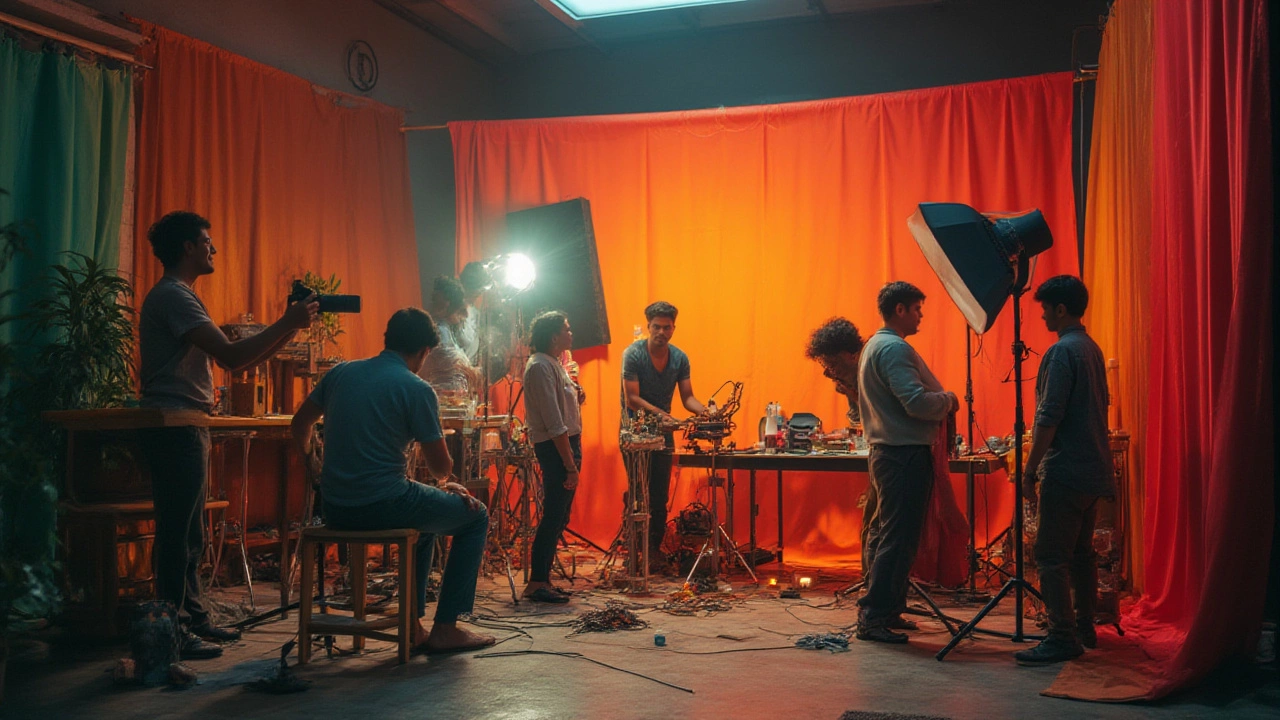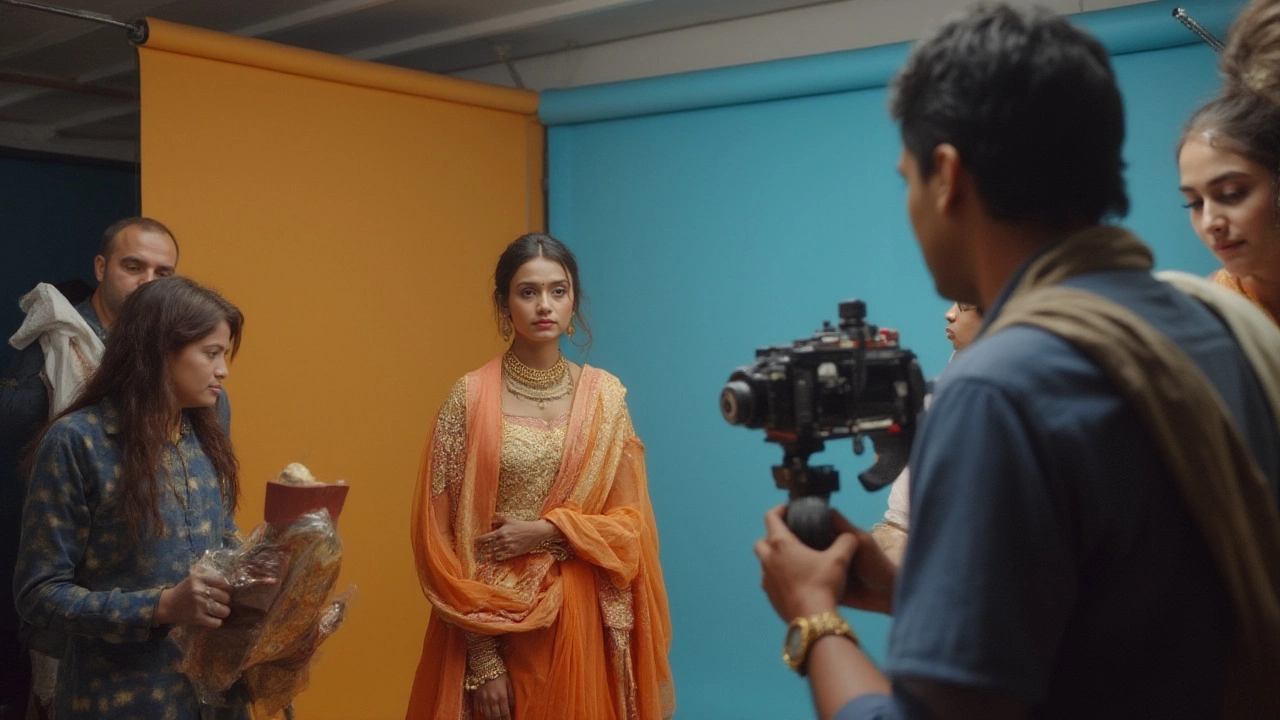Top Studio Mistakes to Avoid: Essential Photography Studio Etiquette and Pitfalls
 Jul, 19 2025
Jul, 19 2025
Ever heard anyone say, "It’s just a studio, how hard can it be?" Here’s the truth: the studio can either make you a legend or leave you fumbling for your gear as your client leaves unimpressed. One wrong move and your perfect setup can turn into a chaos of distractions, miscommunication, and even lost bookings. There are unwritten rules—some simple, some oddly specific—that everyone, whether you’re a newbie with a smartphone or a seasoned pro with years of Canon loyalty, should take to heart. I’ve seen careers sidetracked over a single careless moment or stubborn habit. If you want to master the studio game, you need to know what not to do, as much as what to do.
Ignoring Studio Etiquette: The Fast Track to Awkwardness
Walking into a studio, you’re stepping into someone else’s organized chaos. It’s tempting to just plop your bag, adjust a light, or crank the AC to your liking, but these can be major rookie mistakes. The first rule: never rearrange a studio setup without permission. Even dragging a chair out of frame can wreck the delicate harmony someone spent hours creating. Studios double as creative war rooms for many people, and you never know what shoot comes after yours or what props are off-limits. More than 60% of European photography studios have tight schedules, meaning a single unscheduled move could cost someone their gig.
Food and drinks are another sticky subject. Almost every studio has that one horror story: coffee knocked into a strobe, cookies crumbling into a C-stand, or a greasy fingerprint on a pristine backdrop. Unless you’ve got explicit permission—and a rock-solid way to protect gear—keep those snacks outside. Cleanliness is a big factor here. Did you know a 2023 UK survey found that 92% of photographers refuse to re-book rental studios if they found them dirty after someone else’s session? It’s not just about looking good; it’s about earning trust.
The vibe in a studio isn’t just about lighting or gear. Play your own loud music without a check-in, and you might kill the creative mood or interfere with audio recording. Quick tip: ask if music is okay, and always keep your tunes at a level where everyone can hear each other. Don’t assume everyone’s into your ‘Deep House on Repeat’ playlist. Lastly, don’t bring uninvited guests. Maybe you think having your cousin “just hang out” is harmless, but more bodies in a closed space ramps up distractions and disrupts both workflow and safety. Studios have insurance and guest policies for a reason. If you show up with surprises, nobody’s going to thank you later.
Overlooking Equipment Care: How to Lose Friends and Damage Gear
Ask any working photographer—gear is sacred. Mishandling it is one of the fastest ways to get yourself banned from a studio or, worst case, owing hundreds (even thousands) in repairs. Statistically, about 45% of all studio insurance claims worldwide stem from user-caused gear mishaps. Here’s a reality check: never treat the studio’s equipment like your own. Adjusting the settings on a rental camera, yanking cords out of power packs, or stacking gear on top of delicate reflectors is risky business. Label everything you bring, so nothing gets mixed up. Double-check labels on what you pick up to avoid walking out with someone else’s speedlight or adapter. Studios often use barcode tracking—some in Tokyo now even invoice for a single missing sandbag.
If you’re not familiar with a particular light or modifier, ask for a demo or check the manual before touching. Taking a guess (“It probably works like my Godox at home, right?”) is how you break a $2,000 Profoto head in five seconds flat. Never move or unplug something without a heads-up. With tethered shooting and live video feeds becoming standard, even one unplugged cable can halt an entire production. It’s not just your day you’ll ruin—it might throw off a whole line of booked clients. According to a 2024 U.S. survey of 180 pro studios, half reported least one shoot derailed per month by gear mishandling.
This also means keeping things neat. Learn how to coil cables the right way (the over-under method saves time and stops the wire inside from breaking). Don’t leave stands and tripods set at a “toe-stubbing” height in walkways. Always set gear down in designated storage spots, not just where you finished your last shot. A cluttered floor isn’t just ugly—it’s a tripping hazard, and liability claims have been on the rise. Here’s a quick studio mistakes checklist to keep things running smooth:
- Always check and reset borrowed equipment to default settings
- Report anything broken or malfunctioning the moment you notice it
- Only use gaffer tape where allowed—it leaves less residue than regular tape or duct tape
- Keep food, drink, and bags away from shooting areas and gear tables
- Return things cleaner than you found them
Is that being too careful? Maybe, but no professional ever got in trouble for being too respectful of equipment. In fact, the best studios track gear usage history and will blacklist repeat offenders who get sloppy—even if you're otherwise a great creative.

Disregarding Workflow, Time, and Team Dynamics
Studios operate on tight timelines. Most professional studios in the US and Europe charge by the hour, with fines for overtime that can jump by 25-50% past your booking slot. Time wasted is money lost, and tardiness (even by 10 minutes) can disrupt a whole day’s schedule. Don’t be the person who shows up late and expects to “catch up” on everyone else’s time. Confirm your slot beforehand, show up early, and wrap up all set-ups, breakdowns, and pack-ups on the clock. A London survey from last year found 78% of studio users prefer working with photographers who actually finish 10 minutes early, rather than risk running late.
Miscommunication kills momentum. Never assume everyone is on the same page—share your shot list, lighting needs, and special requests up front. Teams operate smoother when you check in with makeup artists, stylists, and models before firing up the lights. One missing detail, like forgetting to tell the team you’re shooting with gels, can throw hair and wardrobe into crisis mode. Avoid the blame game by being transparent and keeping lines of communication wide open. There’s an art to collaboration in a studio that goes beyond just “being nice.” Respect other people’s prep time and don’t jump in with your own set-up before their work is done.
The stereotype of the “difficult creative” is everywhere for a reason. Small slights add up: snapping at an assistant, refusing to listen to safety briefings, or treating team members like background extras. When you break the team dynamic, you guarantee a tense shoot and subpar results, every time. Remember, your reputation spreads quickly within studio circles. According to Creative Circle’s 2024 market report, 65% of photographers get referrals (or lose them) based on how they treat team members in shared spaces. Here’s a quick workflow-friendly checklist for your next session:
- Arrive at least 15 minutes before your slot
- Share a concise, printed shot list and special instructions
- Check with every team member before big changes (lights, props, music)
- Establish a clear “wrap time” with everyone—don’t assume others know when you plan to finish
- Never blame others for small mistakes—fix it and move on
Need data? Here’s how workflow slips impact studios, according to last year’s European Studio Organization:
| Issue | % Studios Reporting | Cost Per Incident (avg USD) |
|---|---|---|
| Overtime Charges | 63% | 120 |
| Missed Communication | 41% | 100 |
| Late Arrivals | 55% | 80 |
| Unsafe Practices | 29% | 370 |
So, if you respect people’s time and the workflow, you save money and gain a reputation as someone “easy to work with”—that rare quality everyone secretly wants around.
Forgetting Safety, Comfort, and the Human Factor
Studios are loaded with hazards. Tripods, hot lights, cables snaking across the floor—everything’s a potential accident. About 30% of photography studios surveyed in 2023 said that client injuries or close calls happen at least twice a year. A sprained ankle on a cable or a burnt finger on a tungsten head isn’t just a personal headache—it can shutter shoots and land you in legal trouble. Never bypass safety briefings, never climb on ladders or furniture that aren’t for that use, and always keep exits clear. Turn off and unplug power-hungry equipment after you’re done—with energy prices what they are, nobody wants a surprise bill or electrical fire.
The human side matters. The studio can feel sterile, impersonal, or even intimidating for newbies and clients alike. Be aware of discomfort. If a model looks cold in a sleeveless shoot, offer a robe or keep a portable heater handy. Lighting setups can get blinding—don’t ignore squinting or discomfort, as it’ll show in the final images. Ask before using fans, smoke machines, or scented gear. About 18% of models and crew report mild allergies or sensitivities that photographers sometimes overlook, according to a 2024 U.S. survey. It’s just good practice to keep the atmosphere friendly and inclusive.
Controlling your own stress is crucial. Studios are pressure cookers when deadlines loom or tech glitches appear. Don’t lash out at people or, worse, blame the space itself. Spread positivity, thank your team, and take short breaks. Bring music, snacks (for outside the gear areas, obviously), and stay hydrated. Amazing work happens when people feel safe, cared for, and relaxed, not just when the lights are perfect and the gear is top notch. Here are a few comfort-first tips that most forget until it’s too late:
- Always check room temperature before and during the session
- Ask about allergies (to makeup, props, fog machines) ahead of time
- Offer breaks—for both creative ideas and simple rest
- Keep emergency numbers and a first aid kit easily reachable
- Make sure everyone knows where bathrooms and exits are located
Small details can transform a session from a grind to a great memory. Your team, your clients, and yes, even your future bookings will thank you for remembering the stuff that truly matters.